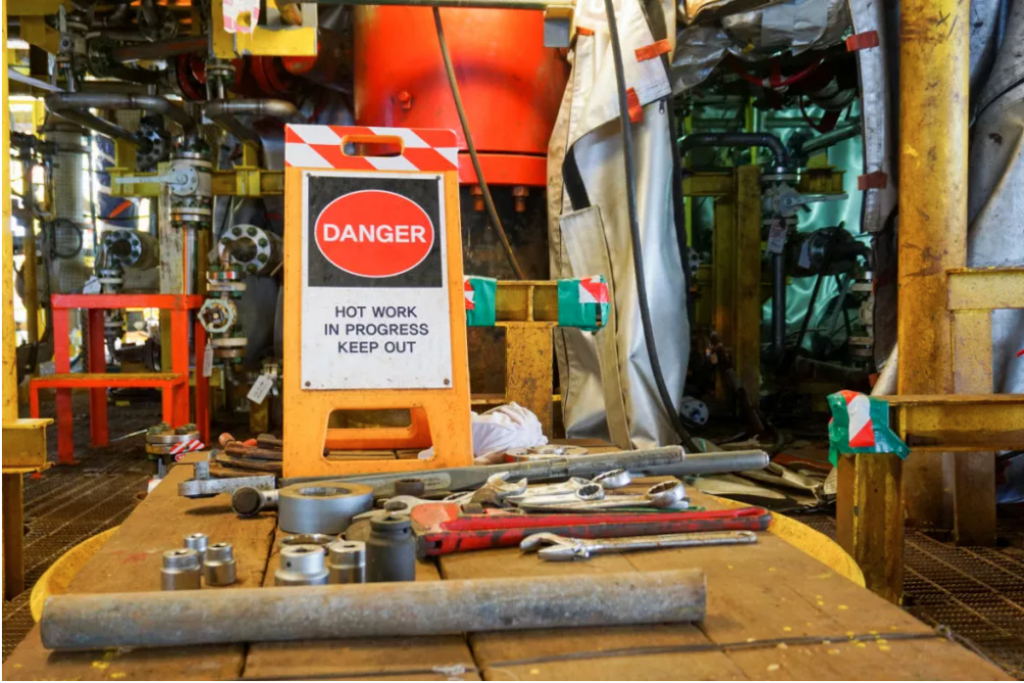According to the National Fire Protection Association (NFPA), from 2014 to 2018, United States local fire departments responded to an average of 4,580 annual structure fires from hot work activities. It was estimated that the annual associated damage costs were approximately $484 million, and an average of 22 people died each year from such operations. Hot work involves any job task that can be a source of ignition and fire hazard. These processes include brazing, soldering, grinding, cutting, welding, and any other spark or flame-inducing work process. In order to conduct this type of work, a Hot Work Permit is required.
What is a Hot Work Permit?
This permit helps employees, contractors, and subcontractors stay safe while doing hot work activities. It ensures that they understand the risks involved and follow safe fire safety practices. It also helps to protect employees from potential harm when doing tasks that involve ignition and can reduce injuries and deaths, as well as costs associated with assets, insurance, and worker compensation.
The permitting system establishes that:
- PPE instructions are followed
- Employees are aware of the present ignition sources
- Isolation practices are followed in the work area before the job starts
- Combustible materials are removed from the premise before the job begins
- Fire extinguishers and first aid kids have been properly inspected and nearby
- Hot work areas are properly cleaned and inspected after the work is complete
- Any incidents relating to hot work are properly reported

Does OSHA Require a Hot Work Permit?
Yes, permits for performing hot work are required by both OSHA and the National Fire Protection Association (NFPA), in addition to the local fire code.
Who Issues the Permit?
In accordance with OSHA standards, contractors are required to apply for these permits through the company’s permit-authorizing individual (PAI). For most job sites, this individual would typically be the Fire Prevention Officer (FPO), Fire Safety Manager, or EH&S representative.
When is a Hot Work Permit Required?
At any point of work where temporary operations of sparks, heat, or open flames are introduced in the work environment, a permit for hot work is required. The permit is required before starting any work, and hot work should not begin until a permit has been received.
The Hot Work Permit Process
There are four general phases during the hot works permitting process – the application phase, the evaluation phase, the work phase, and the sign-off phase.
Application Phase
The process begins when an employee or subcontractor applies for the permit through the on-site permit-authorizing individual, fire safety manager, or other fire safety representative.
Challenges are common at this stage where companies use paper application forms for their permit processing. This challenge arises largely from how easily paper applications can be mishandled and lost, or forgotten altogether as applications are typically submitted the day prior to the start date.
Evaluation Phase
During the evaluation phase, the authorizing individual will conduct an onsite evaluation to authorize the hot work area to ensure it is fire-safe and acceptable for all hot work activities.
Sometimes, people who are responsible for authorizing fire safety permits have trouble recording all the relevant observations at a potential hot worksite, because they have to write everything down on paper forms. This can lengthen the reporting process and can delay the permitted delivery.
Online solutions can help people record and photograph observations in real-time, and quickly generate reports based on the evaluation. It may be helpful to use an online checklist, like the Confined Space Hot Work Permit Checklist, to improve your permit process.

30+ Audit and inspection checklists free for download.
Work Phase
After the job site area has met permit requirements, employees and/or subcontractors are allowed to conduct the hot work process. A paper copy of the permit must be posted outside of the hot work area prior to any work commencing. Once completed, the permit must be signed by the individuals who worked in the area to verify that they have completed their work and a 30-minute fire watch.
Sign-off Phase
The Fire Safety Manager, Fire Prevention Officer (FPO), or other permit-authorizing individuals must return to the hot work site generally within a few hours after the tasks have been completed. This is to confirm that the work was completed and to evaluate for any new fire hazards in the work area.
Do you need a Hot Work Permit?
Whether it is an employee, contractor, or subcontractor, each must be permitted before performing any hot work activities. It is the responsibility of the worker who will be performing the hot work to initiate the permit process. However, everyone involved needs to make sure the necessary steps are taken for a proper permit.
Hot Work Permit Training
All employees who are involved in hot work should also be trained on the permit system during initial safety training. This will ensure that workers will know when to apply for a permit, how, and through who.
You may also be interested in:
Keep It Seen, Keep It Safe: The Importance Of Construction Safety Observations



